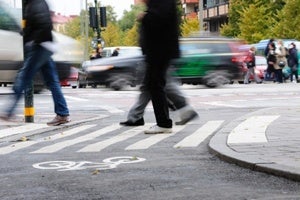December 7, 2011 — When people get hit by cars, what’s the biggest reason? Is it because people don’t pay enough attention when they cross the street? Because cars go too fast? Because people are driving drunk?
Such are the questions that Harvard School of Public Health (HSPH) student Dahianna Lopez asked on a regular basis when she spent two years at the San Francisco Injury Center, served as secretary and later vice chair of that city’s Pedestrian Safety Advisory Committee, and was a board member of Walk SF. Trained as a nurse, Lopez is now a PhD candidate in health policy and a research assistant at the Harvard Injury Control Research Center (HICRC) at HSPH. In a November 17, 2011 talk, part of the HICRC Seminar Series, Lopez discussed a variety of factors that contribute to auto-pedestrian crashes.
As prevention director of the San Francisco Injury Center from 2009 to 2011, Lopez conducted a study of auto-pedestrian crashes in that city. Based on what she learned there, she said the best way to prevent pedestrian injury is to design safe streets that include features such as high-visibility crosswalks, pedestrian countdown signals, center median strips, good lighting, raised crosswalks, and “bulbouts”—big squares of sidewalk that extend into the street at crossing areas.
Lopez presented a wealth of statistics to support her suggestions on ways to boost pedestrian safety. For example, the National Highway Traffic Safety Administration reported that 70 percent of all pedestrians killed by cars in 2009 were killed at night, so making sure that streets are well lit is one way to help prevent pedestrian deaths.
Citing other studies, Lopez said that pedestrian countdown signals reduce the rate of injury by 25 percent, and that bulbouts—which reduce the distance for pedestrians to cross streets—reduce injury rates by about 65 percent.
“In terms of urban planning, we want to create an environment that’s walkable by including a lot of these engineering installations,” said Lopez.
Enforcing traffic regulations is another big factor, she added, noting that good traffic enforcement has been found to reduce auto-pedestrian crashes by roughly 23 percent.
Lopez hopes to continue her work on pedestrian and bicycle safety in Boston, New York, and other countries such India and Mexico.
For a copy of the presentation with references, please contact Dahianna Lopez.
–Karen Feldscher
photo: iStockphoto.com/olaser
